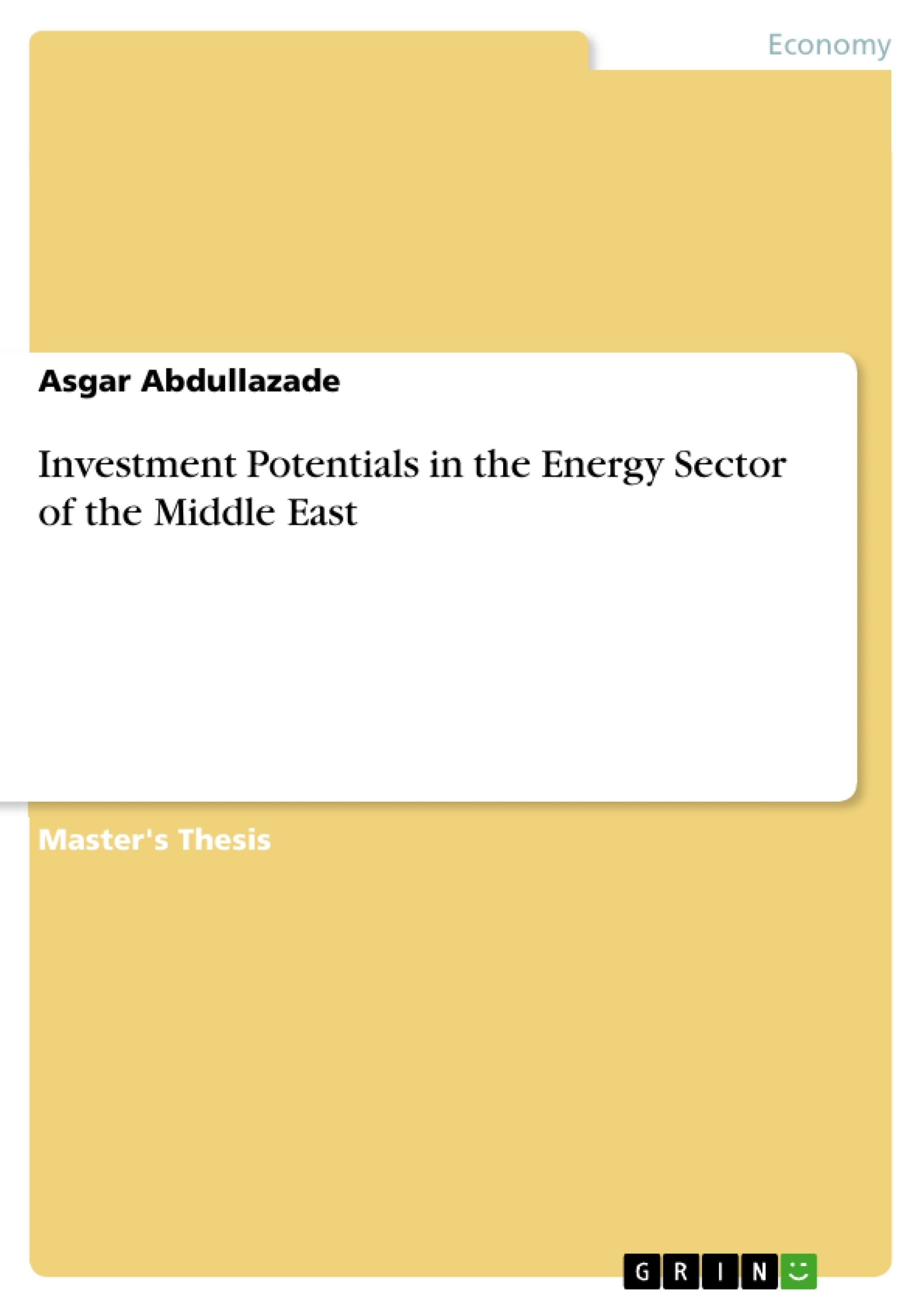The Middle East countries Iran, Iraq and Saudi Arabia that were analyzed for investment potentials possess natural energy resources in copious amounts, share a high dependency on oil or gas while renewables barely play any role and have strong religious tendencies in politics as well as differences compared to western countries when it comes to aspects of cultural, religion, understanding and business practices.
The most promising investments that were stated out are: LNG liquefication facility in Iran, since Iran has large natural gas reserves and production capacities, but doesn’t export gas at all. PV modules for Iraq, since expensive projects are comparably risky in this country and some of the population has no or just limited access to electricity – the demand exceeds the supply. For Saudi Arabia, larger scale solar power plant projects like Parabolic Troughs are most promising, since Saudi Arabia is very dependent on oil and has a very high carbon dioxide emission and a weak energy diversity.
Especially the liquefication facility in Iran seems to have enormous potential on the long run. The implementation of PV in Iraq is highly dependent on the business model and governmental support. Such support is also needed for the solar power plant in Saudi Arabia, since the electricity prices are subsidized in a way, that the electricity generated through a Parabolic Trough would most likely be not competitive without any form of support. However, such support is likely, since the project is very beneficial for Saudia Arabia and huge investments in the energy sector are planned anyways.
For the further realization of such projects its mandatory to make a sophisticated economically and feasibility analysis that considers all the relevant variables and more specific information and data. But especially renewable energies which are massively underrepresented in the Middle East seem to have a good potential which will probably increase further since more experience and better technologies are achieved.
The Middle East is a region with large natural resources and therefore with a theoretically enormous amount of investment possibilities. However, big players, state-owned companies, restrictions and difficulties regarding law, culture and business practices can overall decrease the attractivity of investments in this area.
Inhaltsverzeichnis (Table of Contents)
- 1 Introduction
- 2 Fundamentals
- 2.1 The Energy Sector
- 2.1.1 Definitions
- 2.1.2 Relevance
- 2.1.3 Source of Energy
- 2.2 The Middle East
- 2.2.1 Iran
- 2.2.2 Iraq
- 2.2.3 Saudi Arabia
- 2.1 The Energy Sector
- 3 Critical Analysis
- 3.1 Investment Potentials in Iran
- 3.1.1 Energy Sector Evaluation
- 3.1.2 Identification of Influential Forces
- 3.1.3 Consideration of Risks and Potential Hurdles for Investors
- 3.1.4 Identification of Potential Projects
- 3.1.5 Evaluation of Iran as Target for Investments in the Energy Sector
- 3.2 Investment Potentials in Iraq
- 3.2.1 Energy Sector Evaluation
- 3.2.2 Identification of Influential Forces
- 3.2.3 Consideration of Risks and Potential Hurdles for Investors
- 3.2.4 Identification of Potential Projects
- 3.2.5 Evaluation of Iraq as Target for Investments in the Energy Sector
- 3.3 Investment Potentials in Saudi Arabia
- 3.3.1 Energy Sector Evaluation
- 3.3.2 Identification of Influential Forces
- 3.3.3 Consideration of Risks and Potential Hurdles for Investors
- 3.3.4 Identification of Potential Projects
- 3.3.5 Evaluation of Saudi Arabia as Target for Investments in the Energy Sector
- 3.1 Investment Potentials in Iran
- 4 Discussion
- 4.1 Most Promising Investments
- 4.2 Economic Analysis
- 4.3 Results
Zielsetzung und Themenschwerpunkte (Objectives and Key Themes)
This master's thesis examines the investment potential in the energy sector of Iran, Iraq, and Saudi Arabia. The analysis considers the countries' natural resources, dependence on oil and gas, limited role of renewables, and cultural and religious factors. The main goal is to identify potential investment opportunities and analyze their feasibility, taking into account economic, political, and social considerations.- The impact of natural resources and energy dependence on investment opportunities.
- The role of cultural and religious factors in investment decision-making.
- The potential of renewable energy in the Middle East.
- The challenges and risks associated with investing in the energy sector of the Middle East.
- The evaluation of potential projects, including liquefaction facilities, PV modules, and solar power plants.
Zusammenfassung der Kapitel (Chapter Summaries)
- Chapter 1: Introduction provides an overview of the thesis and its objectives.
- Chapter 2: Fundamentals lays the groundwork for the analysis by defining key terms, discussing the relevance of the energy sector, and providing an overview of the Middle East region, with a focus on Iran, Iraq, and Saudi Arabia.
- Chapter 3: Critical Analysis investigates the investment potential in each country, focusing on its energy sector evaluation, identifying influential forces, considering risks and hurdles for investors, identifying potential projects, and evaluating the country as a target for investments in the energy sector.
- Chapter 4: Discussion delves into the most promising investments, their economic analysis, and the overall results of the study.
Schlüsselwörter (Keywords)
The main keywords and focus topics of the master's thesis include: investment potential, energy sector, Middle East, Iran, Iraq, Saudi Arabia, natural resources, oil and gas, renewables, cultural factors, religious factors, economic analysis, feasibility, risks, hurdles, potential projects, liquefaction facilities, PV modules, solar power plants.- Quote paper
- Asgar Abdullazade (Author), 2016, Investment Potentials in the Energy Sector of the Middle East, Munich, GRIN Verlag, https://www.grin.com/document/387462



